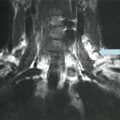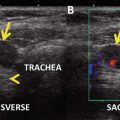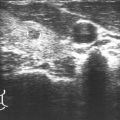Features
Sensitivity (%)
Specificity (%)
NPV (%)
PPV (%)
Accuracy (%)
Prevalence (%) in normal LNs
Suspicious for malignancy
Punctate hyperechogenicity
5–69
93–100
33–60
88–100
56–72
0
Cystic aspect
10–34
91–100
30–66
77–100
48–65
0
Peripheral/Diffuse vascularization
40–86
57–93
31–70
77–80
54–71
1–18
“Thyroid-like” hyperechogenicity
30–87
43–95
38–84
66–96
56–90
4–17
Indeterminate
Round shape
37
70
45
63
–
4-36
Hilum absent
90.4–100
29–40
67.3
75.9
–
–
Normal
Hilum present
0.5
–
–
–
–
29–48
Vascularization absent
0
–
–
–
–
33–36
Cytological assessment of an FNAb specimen is the most common method for confirming metastatic involvement of lymph nodes with indeterminate or suspicious sonographic features. The aspiration should be performed under US guidance by an experienced operator [defined by the European Thyroid Association (ETA) as one who performs at least 150 procedures per year and maintains an inadequate sampling rate below 10 %] [11]. Material is collected with 24- to 27-gauge needles (two or more passes) and smeared on slides or suspended in liquid phase for cytological examination. False-negative results occur in 6–8 % of all cases (due to sampling error), and up to 10 % of samples prove to be inadequate for diagnosis. When cytological and sonographic findings conflict (i.e., normal cytology vs. suspicious sonographic features) or the FNAb sample is inadequate, further diagnostic testing can be undertaken.
The diagnostic yield of an FNAb can be enhanced by assaying Tg levels and/or thyroid-specific gene transcripts in washout fluid from the needle used to collect the cytology aspirate [13] or by another dedicated pass for thyroglobulin or genetic analysis. For the Tg assay, the needle is generally flushed with 1 cc of normal saline. The washout is analyzed using an immunometric assay with a functional sensitivity between 0.1 and 1 mcg/L [11] that has been precalibrated in line with the CRM 457 standard. The results are expressed in nanograms per milliliter, and normal cut-offs vary. The ETA regards levels below 1 ng/mL as normal and those above 10 ng/mL as compatible with thyroid cancer metastasis in a thyroidectomized patient [11]. Values between 1 and 10 ng/mL should be interpreted together with cytology results [11].
Immunometric Tg assays can produce falsely low results in the presence of high Tg concentrations if the excess antigen saturates the binding capacity of the antibodies in the solid-phase support. This so-called hook effect [14] can be excluded by assaying serial dilutions of the sample [15]. The reported sensitivity of washout fluid Tg levels for identifying thyroid cancer lymph node metastases ranges from 88 to 100 % with a specificity from 69 to 100 % [10, 13, 15–18]. This assay can be informative even in the presence of Tg antibodies (AbTg) [16, 19], although false-negative results can also occur in this setting [17]. False negatives are also possible in the presence of anaplastic or poorly differentiated thyroid cancer metastases [16]. False-positive results have also been reported, mainly when a remnant of normal thyroid is mistakenly identified as a suspicious level VI lymph node [13].
When cytology and washout fluid Tg levels are both noninformative, assaying a sample of the FNAb washout for mRNA for thyroid-specific genes (e.g., TSH receptor, Tg) may be useful. The washout in this case is performed with an RNA stabilization solution and the sample frozen for later assay. With polymerase chain reaction amplification, this approach can correctly identify the presence of metastatic tissue, even when the washout fluid contains only a few cells [18]. Its accuracy is substantially better than aspiration cytology or Tg assay of washout (100 % vs. 85 % and 73 %, respectively) [18]. However, this assay is probably available only in tertiary care centers.
It is important to note that the presence of a lymph node with indeterminate or suspicious US findings is not always an indication for FNAb: the latter should be offered only if the results will have a real impact on patient management [3, 4]. Confirmation of locoregional metastatic involvement is often followed by further treatment, but if this course of action is already precluded by factors like advanced age, comorbidities, or simple patient preferences, an FNAb serves little purpose.
Once the presence of metastatic lymph node involvement has been established, the most effective therapy [20] and the first-line approach recommended by the American Thyroid Association (ATA) Practice Guidelines [3, 4] is surgery. The first reoperation is often (50–70 % of patients), but not invariably, successful in eradicating the disease [20–22]. However, reoperation carries an increased risk of permanent complications [23–25], including nerve resection (e.g., recurrent laryngeal, spinal accessory, and phrenic nerves), hypoparathyroidism, and tracheal or esophageal damage. Decisions have to be based on careful analysis of costs, benefits, and patient preferences. The actual risk of complications depends in part on the skill and experience of the surgeon, so the availability of surgeons specifically trained in neck revision procedures is a critical factor to consider. The proximity of the metastatic node to vital structures in the neck should also be taken into account.
The ATA recommends that surgery should be considered for central neck nodes measuring >8 mm and lateral neck nodes with diameters of >10 mm. For smaller nodes or those that remain stable over time, conservative management based on active surveillance is more appropriate [3, 4]. Only 20 % of all suspicious lymph nodes exhibit volume increases over time [26]. Those posing no threat to vital structures that show no signs of growth can be safely and effectively monitored with periodic (every 6–12 months) US examinations [3, 4, 11]. The patient’s wishes and emotional concerns naturally have to be weighed and addressed in all decisions.
Stay updated, free articles. Join our Telegram channel

Full access? Get Clinical Tree






